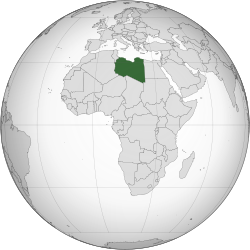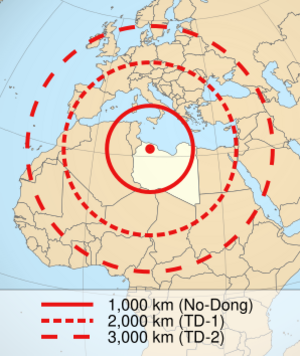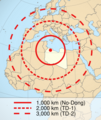Libya and weapons of mass destruction facts for kids
Quick facts for kids Libya |
|
|---|---|
| Nuclear program start date | 1969 |
| First nuclear weapon test | None |
| First fusion weapon test | None |
| Last nuclear test | None |
| Largest yield test | None |
| Total tests | None |
| Peak stockpile | None |
| Current stockpile | None; the program was dismantled in 2003. |
| Maximum missile range | 300 km (Scud-B) |
| NPT signatory | Yes |
From 1969, when Muammar Gaddafi took control, Libya tried to get or build dangerous weapons. These are called weapons of mass destruction. They include nuclear, chemical, and biological weapons. Libya also wanted long-range missiles.
However, on December 19, 2003, Gaddafi announced a big change. Libya would willingly get rid of all its materials, equipment, and programs for these weapons. This was a major step towards peace.
Libya had signed the Nuclear Non-Proliferation Treaty (NPT) in 1968 under King Idris. Gaddafi approved it in 1975. This treaty aims to stop the spread of nuclear weapons. Libya also agreed to let the International Atomic Energy Agency (IAEA) check its nuclear activities. The United States and the United Kingdom helped Libya remove its nuclear materials. The IAEA checked to make sure everything was gone.
In 1982, Libya also agreed to the Biological Weapons Convention. This treaty bans biological weapons.
In 2004, Libya joined the Chemical Weapons Convention. It declared that it had mustard gas and chemicals for making sarin. It also had many empty chemical weapon bombs. Libya started destroying these chemicals in 2004. The destruction of these dangerous chemicals was finished in November 2017.
Libya signed the Treaty on the Prohibition of Nuclear Weapons in 2017. This treaty bans nuclear weapons.
Contents
Libya's Nuclear Program
Libya's King Idris signed the Treaty on the Non-Proliferation of Nuclear Weapons in 1968. But after Muammar Gaddafi took power in 1969, he wanted to get nuclear weapons. Libya's secret nuclear program was meant to balance against what they thought was Israel's nuclear ability.
Gaddafi approved the NPT in 1975. He also agreed to let the IAEA check Libya's nuclear sites. In 1981, the Soviet Union built a research reactor in Tajura, Libya. Libya also bought over 2,000 tons of uranium from Niger.
During the 1980s, Gaddafi tried to get nuclear weapons through secret networks. He used people like Swiss engineer Friedrich Tinner. The IAEA reported that in 1995, Libya decided to restart its nuclear work. This included trying to enrich uranium using special machines called gas centrifuges. This process can make uranium for nuclear reactors or for nuclear weapons.
However, when Libya stopped its program in 2003, it was still very early. The program was just starting to develop.
Seeking Help from Other Countries
Gaddafi tried many times to buy nuclear weapons from other countries. In 1970, he visited China. He tried to convince China's leader, Zhou Enlai, to sell him a nuclear bomb. But China said no. Gaddafi said he wanted nuclear weapons because he was worried about Israel's nuclear program.
In 1974, Libya tried to join Pakistan's nuclear program, called Project-706. Libyan technicians went to Pakistan in 1977. But Pakistan's new leader, General Zia-ul-Haq, did not trust Gaddafi. He asked the Libyans to leave. Pakistan's spy agency, ISI, even stopped Libyan agents trying to get nuclear secrets. Investigators later found that the nuclear weapon designs Libya got came from China, through a secret network.
After this, Gaddafi improved relations with India in 1978. India and Libya signed a nuclear energy agreement in 1984. This was part of India's "Atoms for Peace" program. But it's not clear how much nuclear cooperation actually happened.
Throughout the 1980s, Libya kept trying to get nuclear weapons from different sources. In 1978, Libya tried to get access to uranium ore and ways to enrich uranium. This would have allowed them to make uranium for weapons. This plan failed in 1979. So, in 1980, Libya decided to try making plutonium for weapons instead.
Libya bought 1,200 tons of uranium ore from Niger. They did not tell the IAEA about this, which they were supposed to do. In 1982, Libya tried to buy a small factory from Belgium to make a chemical called UF4. Libya had no declared nuclear sites that needed this chemical, so Belgium refused the sale.
In 1980, Libya started building its nuclear setup using parts from secret markets. A Swiss person named Friedrich Tinner provided centrifuge materials and knowledge. His work was done at the Tajura Nuclear Research Facility (TNRF). The goal was to make gas centrifuges to enrich uranium. By the late 1980s, money problems and sanctions from the United States slowed the program. Tinner finished his work in 1992, but Libya still couldn't make a working centrifuge.
After the Cold War ended, Gaddafi tried to convince U.S. President Bill Clinton to lift sanctions. He offered to get rid of Libya's nuclear program.
In 1995, Gaddafi again called for nuclear weapons. He looked for new ways to get nuclear technology. In 1997, Libya received technical papers and materials for gas centrifuges from various secret sources. Libya got 20 already-built centrifuges and parts for 200 more. They installed one centrifuge at the Al Hashan site. It was successfully tested in October 2000.
In 2000, Libya worked faster on its program, still with Tinner's help. Libya got many documents about centrifuge designs. But they had trouble understanding them. Libya told IAEA investigators that they didn't have anyone skilled enough to understand these designs. They would have needed help from the supplier to make a nuclear weapon.
Help from the Soviet Union
In 1979, Libya worked with the Soviet Union on peaceful nuclear projects. The Soviet Union agreed to build a 10 MW research reactor in Tajoura in 1981. This reactor was under IAEA checks.
Libya's nuclear program often had problems with bad management. The Tajura facility was run by Soviet experts. It had only a few inexperienced Libyan workers. At this facility, called the Tajura Nuclear Research Facility (TNRF), Libya did illegal uranium experiments. The IAEA said an unnamed nuclear weapon state also helped Libya with these experiments. Experts like David Albright thought it was likely the Soviet Union or China.
In 1984, Libya tried to get nuclear power plants from the Soviet Union. But Gaddafi didn't like their old technology. He also tried to negotiate with Belgium and Japan for nuclear technology, but these talks failed or didn't lead to much.
In 1991, Libya tried to get nuclear technology, experts, and materials from the Soviet Union as it was falling apart. There were reports that Libya tried to hire Russian scientists. In 1998, Russia and Libya signed a contract to fix up the Tajura Nuclear Research Center.
Ending the Program
The Clinton administration in the U.S. worked to get Libya to give up its nuclear program. These talks started in the 1990s.
Chemical Weapons Program
Under Gaddafi, Libya had a strong chemical weapons program. This program was later stopped in the 2000s and early 2010s. This happened as Gaddafi tried to improve relations with Western countries. Libya joined the Chemical Weapons Convention in 2004. It declared it had 24.7 tons of mustard gas and 1,390 tons of chemicals for making sarin. It also had 3,563 empty chemical weapon bombs.
The Organisation for the Prohibition of Chemical Weapons (OPCW) watched over the destruction of Libya's chemical weapons. This continued until February 2011, when fighting started in Libya. By then, Libya had destroyed 40% of its chemical ingredients and 55% of its mustard gas. It also destroyed 3,500 chemical weapon bombs.
In September 2011, the OPCW said the remaining weapons were safe. They had not fallen into the hands of armed groups. But later, a hidden supply of mustard gas was found. In December 2012, an official said that armed groups might have gotten chemical weapons from Libya.
Libya's new government worked with the OPCW to destroy the remaining chemical weapons. By September 2013, there were still some mustard agents and other chemical ingredients left.
In February 2014, the United States and Libya secretly destroyed the rest of Libya's chemical weapons. They used a special portable oven.
In September 2014, the OPCW said Libya still had about 850 tons of industrial chemicals. These could be used to make chemical weapons. Libya asked for help to move these chemicals out of the country for destruction. On August 31, 2016, the last of these ingredients were moved to Germany. This was to stop them from falling into the wrong hands. The destruction of Libya's chemical weapon ingredients was completed in November 2017.
Ballistic Missiles
During the First Libyan Civil War in 2011, Gaddafi's forces reportedly fired several Scud-B missiles. These missiles were aimed at areas that were fighting against his rule. These included Misrata and Ajdabiya. However, the missiles missed their targets. Later, more Scud missiles and their launchers were found by anti-Gaddafi fighters near Tripoli and Sirte.
See also
- Foreign relations of Libya
- Nuclear technology
Images for kids




